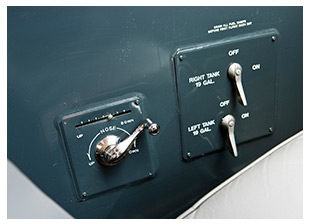Training Tips |
Time to trim?
Trim makes flying facile. Set power and pitch for the airspeed and vertical rate you desire. Then a trim adjustment lets you fly "hands off" until a change is necessary. Retrimming isn't always needed when making changes: If you have been flying straight and level and wish to descend at the same airspeed, simply reduce power. The aircraft will pitch down slightly and descend at your trimmed airspeed—easy! A configuration change such as adding flaps requires that you adjust the pitch attitude to maintain a constant airspeed, then retrim. With practice you can make this a simple process. For example, in a high-wing Cessna 150, adding 10 degrees of flaps will cause the nose to pitch up slightly—but if you reduce power slightly just after setting the flap position, the nose-down response to the power change should cancel out the nose-up effect of adding flaps. What's a better idea during a rapid series of airspeed and/or configuration changes, or when practicing maneuvers: retrimming for each, or simply holding the needed control pressures? That's a question many student pilots ask as they work to master trim technique. One answer doesn't fit all scenarios or apply to all aircraft. An aircraft that is light in pitch and easily controlled with yoke or stick pressure may make less trim demand on the pilot during a maneuver than, say, a four-seat aircraft with a reputation for nose heaviness, that is being flown at a center-of-gravity position close to the forward limit, as would be the case with only the front seats occupied. In any aircraft, the answer also depends on the flight task. A brief climb to correct a minor altitude excursion, after which you will resume your previous cruise airspeed, could be accomplished with a simple addition of power and back-elevator pressure, followed by leveling off and returning to your cruise power setting. By contrast, a 360-degree steep turn might prove difficult without some assistance from the trim system to help you maintain the needed up-elevator input. One scenario in which trimming is the safe choice is during landing—especially when close to the ground. "Ground effect decreases elevator control effectiveness and increases the effort required to raise the nose," explains the Airplane Flying Handbook. Let the trim system help keep your flying smooth—and safe! Training ProductsASA releases test prep books for 2014ASA has just released the 2014 editions of its Test Prep Books series, which include questions and answer stems for all the FAA knowledge exams. Supported with explanations and organized into chapters based on subject matter for efficient studying, each book identifies the specific questions for the test to which it applies: airplane, rotorcraft, gyroplane, glider, lighter-than-air, or weight-shift control. Book covers operating aircraft safelyIn his book Understanding Flying, author Richard Taylor helps students and pilots find their flying flaws. He also explains everything you need to know to operate an airplane safely. The cost is $24.95. Note: Products listed have not been evaluated by ePilot editors unless otherwise noted. AOPA assumes no responsibility for products or services listed or for claims or actions by manufacturers or vendors. Final ExamQuestionYou and a friend are going to fly to a new restaurant for dinner and return home afterward. While you are planning the flight, you notice that you will arrive at your destination 15 minutes before the end of civil twilight. The return leg will all be at night. What are the minimum fuel reserves you must have for each leg? AnswerYou will need a 30-minute reserve on the flight to the destination and a 45-minute reserve on the return trip. FAR § 91.151 specifies the VFR fuel requirements and states in part: "(a) No person may begin a flight in an airplane under VFR conditions unless (considering wind and forecast weather conditions) there is enough fuel to fly to the first point of intended landing and, assuming normal cruising speed-
1) During the day, to fly after that for at least 30 minutes; or Night is defined in FAR § 1.1 as "the time between the end of evening civil twilight and the beginning of morning civil twilight, as published in the American Air Almanac, and converted to local time." Got a question for our technical services staff? Contact AOPA. |



